- About MAA
- Membership
- MAA Publications
- Periodicals
- Blogs
- MAA Book Series
- MAA Press (an imprint of the AMS)
- MAA Notes
- MAA Reviews
- Mathematical Communication
- Information for Libraries
- Author Resources
- Advertise with MAA
- Meetings
- Competitions
- Programs
- Communities
- MAA Sections
- SIGMAA
- MAA Connect
- Students
- MAA Awards
- Awards Booklets
- Writing Awards
- Teaching Awards
- Service Awards
- Research Awards
- Lecture Awards
- Putnam Competition Individual and Team Winners
- D. E. Shaw Group AMC 8 Awards & Certificates
- Maryam Mirzakhani AMC 10 A Awards & Certificates
- Two Sigma AMC 10 B Awards & Certificates
- Jane Street AMC 12 A Awards & Certificates
- Akamai AMC 12 B Awards & Certificates
- High School Teachers
- News
You are here
Poker-Faced Over the Phone
October 2009
Dedicated to Martin Gardner, prince of recreational mathematics
and American man of letters, on the occasion of his 95th birthday.
For the fifth anniversary of the first Card Colm, from October 2004, we offer this mathemagical entertainment. While it proports to be about poker, nothing could be further from the truth; that's just a marketing ploy. It is based on an effect found in the contribution "Horses In the Stream and Other Short Stories" from the book Homage to a Pied Puzzler (A.K. Peters, 2009). The author of that piece, Earnest Hammingway, has kindly allowed us to adapt it here.
Find somebody who really likes the game of poker, and hand that person a deck of cards, which you have just removed from its box. Ask for a "very good—but not perfect—poker hand" to be freely selected and given to you.
Take the rest of the deck back too, and place it to one side. Survey the five selected cards, moving them around in a displayed fan in one hand, as you comment, "I see you opted for two Queens and two Aces; very interesting!" as appropriate, depending on the specific cards selected.
Place the five cards in a neat face-up row on the table, and continue, "I'm going to make you an offer you don't often get in real life: the chance to improve that poker hand. Please slide out one card, to be replaced in a moment with another one, of your choice, from the rest of the deck." Note that from now on you never touch the displayed row of cards; don't be shy about pointing this out.
Perhaps the cards on display are these ones:
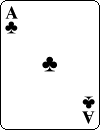
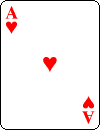
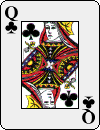
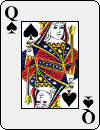
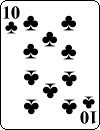
The poker fan decides on which card to jettison, and slides it out as directed. You set that card aside, and hand back the rest of the deck. "Please, choose any card you wish to replace that other card. I forgot to say there is one minor requirement: if the card you are replacing had a red face, then you must put a black one in its place, and vice versa. That still gives you a lot of freedom to improve your hand."
Once the substitution has been made, you ask that the card box be picked up and shaken out. A piece of paper tumbles to the table, on which is written a name, say Jeff's, and a phone number.
"Please call Jeff at that number and, in your own words and your own time, read out to him the names of the five cards in the row on display here. It's reallly important to remain poker-faced, so that Jeff gets no hint as to which is the new card."
Once the instructions have been understood, continue, "However, Jeff is a master of human psychology, and he rarely makes a mistake. My bet it that no matter how hard you try to be matter-of-fact and dispassionate, your voice will give you away. When you get to the card you switched, you'll get emotional, and he'll know!"
For public performance, a speaker phone can be used; otherwise only the poker fan will hear Jeff's pronouncement.
For instance, had the 10♣ in the above display been replaced with another Queen, the display might now look like this:




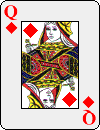
In any case, shuffle the jettisoned card back into the rest of the deck while the phone call is taking place. Soon after the poker fan reads out the list of card names, in the order displayed, Jeff correctly announces which card was not in the original poker hand. This stunt can be repeated as often is wished.
Given Any Five Cards
This two-person card trick falls squarely into the "Given Any Five Cards" category, which is particularly appropriate as we pause to acknowledge the 95th birthday of Martin Gardner, prince of recreational mathematics and American man of letters, who still writes more books in a year than most people do in a lifetime.
It was Martin Gardner who first brought the public's attention to the original classic "Given Any Five Cards" two-person card trick from sixty years ago, namely mathematician Fitch Cheney's Five Card Trick, in his landmark Mathematics, Magic and Mystery book (Dover, 1956).
It was also Cheney's gem which got this author hooked on mathematical card tricks a decade ago. Magic, or coincidence? You be the judge. That trick, and variations thereon, hooked some new fans recently thanks to a fresh airing this past May in the New York Times.
So what is really going on here in the single card switch in a poker hand trick?
The underlying mathematical fact which makes this trick possible is the following:
in a face-up row, then step back never to touch them again, so that a subsequent
card switch performed by another person, black for red or red for black, is detectable
by a mathemagical accomplice, who only gets to see the row after the switch.
There is a convention which you and Jeff have agreed on, ahead of time, about how you arrange whatever cards you are given. It has absolutely nothing to do with poker hands, that's just a hook to generate interest!
Any binary identifier, such as odd versus even or prime versus composite, can be used in place of red versus black as the guiding principle in the switch, though which one you use of course determines the order in which you first lay out the five cards.
First we explain a "symmetric way" to perform this effect which we later suggest modifying so as to disguise the underlying principle. Let's first agree on a total ordering of the deck, such as the standard CHaSeD, actually all that we need to assume here is that ♣'s come before ♠'s, and ♥'s come before ♦'s. Within suits, cards are in ascending order from Ace to King.
There are two types of cases to consider:
The Easy Cases: Suppose that among the five cards you are handed, there are precisely zero, three or four Red cards.
-
Zeroth Case: You have no Red cards at all. Arrange the five Black cards in ascending order, with respect to the ♣'s then ♠'s ordering.
-
Third Case: You have three Red cards. Arrange the cards in a row in the order Red, Black, Red, Black, Red, where both the Reds and Blacks considered separately are in ascending order, with respect to the ordering just discussed.
- Fourth Case: You have four Red cards. Arrange the cards Red, Red, Black, Red, Red, where the Reds are in ascending order, i.e., the ♥'s come before the ♦'s.
The Not Hard Cases: If, on the other hand, among the five cards you are handed, there are not zero, three or four Red cards, there is a good reason: you must have precisely zero, three or four Black cards! This is because you have one, two or five Red cards, and conveniently {0, 3, 4} = 5 - {5, 2, 1}.
-
First Case: You have just one Red card. Arrange the cards Black, Black, Red, Black, Black, where the Blacks are in descending order, i.e., the ♠'s precede the ♣'s (and the card values drop within each suit).
-
Second Case: You have two Red cards. Arrange the cards in a row in the order Black, Red, Black, Red, Black, where both the Reds and Blacks considered separately are in descending order.
- Fifth Case: You have all Red cards. Arrange them in descending order, with the ♦'s preceding the ♥'s.
This table summarizes the Black/Red patterns suggested above, with the Not Hard Cases in italics. It accounts for 6 of all 32 possible Black/Red displays; the point being that any Black/Red distribution can be rearranged to yield one of these 6 patterns.
| Case | Pattern |
| Zeroth | B, B, B, B, B (<) |
| First | B, B, R, B, B (>) |
| Second | B, R, B, R, B (>) |
| Third | R, B, R, B, R (<) |
| Fourth | R, R, B, R, R (<) |
| Fifth | R, R, R, R, R (>) |
Note how in all cases the final display is symmetrical. In the Easy Cases, the middle (third) card is Red (think 1 = 1 + 0) if the first two cards consist of one Red (1) and one Black (0), in any order; otherwise the middle card is Black (think 0 = 0 + 0 = 1 + 1 mod 2). Similar observations apply in the Not Hard Cases, with a convention switch: now Black corresponds to 1 and Red to 0.
Suppose you display the five given cards in a row such as one of these. Then, as explained below, it is possible to Jeff to deduce which of these patterns was in effect before the card switch, just from knowing the later pattern. The problem is that the poker fan may spot the symmetry in the pattern which you display, and (incorrectly) suspect that in many cases it's the breaking of that symmetry which later helps Jeff to deduce which card was switched.
A simple way around this is to determine in your mind the correct card sequence C1, C2, C3, C4, C5, but instead of laying the cards out that way, use a "one ahead principle" and display C2, C3, C4, C5, C1 (note the wrap-around). In four cases out of six this results in an asymmetrical row. In the remaining monochrome (all Red or all Black) cases, there will always be the suspicion that Jeff merely plumps for the "odd one out" from the resulting post-switch display, but in such cases you can truthfully point out that such patterns could have arisen in many other ways and how would Jeff know which one it was?
For actual performance, we recommend the one card shift just discussed. That convention was followed in the rows of cards displayed earlier on. In what follows, however, we work with the easier-to-handle symmetric version. Hence, when considering Jeff's perspective, especially if one desires to equip him with a crib sheet in advance (which nobody will see over the telephone), everything needs to be shifted one back to compensate for the above one ahead shift.
(Other permutations of C1, C2, C3, C4, C5 can be used to disguise the inherent symmetry of the suggested "consistent coding" of the cards.)
Energised In Degrees
The poker fan alters a modification (as discussed above) of one of these nice symmetric displays with a single switch, either a Red for Black or a Black for Red. So what pattern might Jeff see when he quickly scribbles down what is read out to him over the phone, and how will he deduce what it was before the switch?
While the situation as Jeff perceives it depends on which of the cards has been switched, the good news is that there are monochromatic "dominant subsequences" which tip him off as to whether it's an Easy or Not Hard case, and ultimately, to which card was switched.
We examine the six possible Situations as Jeff sees it (namely, how many Reds are on the list of cards read over the phone to him) and their relationship to the six possible Cases from before that gave rise to those Situations. Assume that for quick reference, Jeff writes down in a list the card names read out to him, in order.
Situation 0 or 1: Suppose he sees zero or one Red card. Situation 0 could only arise from the First Case, in which case the middle Red was originally Black. Situation 1 could only arise from the Zeroth or Second Cases. In the former case, Jeff will see four Blacks in ascending order, and know that the switched card is the one Red in the row. In the latter case, he'll see four Blacks which contain an unmistakable dominant descending subsequence of length three (or maybe four), and know that it arose from the Second Case, and hence the switched card is whichever of the second or fourth ones is now Black.
Situation 2 or 3: Suppose he sees two or three Red cards. b>Situation 2 here could only arise from the First or Third Cases. The former case can be recognized for sure by the presence of three descending Black cards, and the switched card is the non-central Red one. The latter case is distinguished by two Reds which are in ascending order and three Blacks which are not in descending order, and the switched card is whichever of the first, third or fifth one is now Black. Situation 3 is similar, with the roles of Red and Black reversed.
Situation 4 or 5: Finally, suppose Jeff sees four or five Red cards. Situation 4 could only arise from the Third or Fifth Cases. In the former case, Jeff will see four Reds, which contain an unmistakable dominant ascending subsequence of length three (or maybe four), and know that it arose from the Third Case, and hence the switched card is whichever of the second or fourth ones is now Red. In the latter case, he'll see four Reds in descending order, and know that the switched card is the one Black in the row. Situation 5 could only arise from the Zeroth Case, in which case the middle Black was originally Red.
Here is crib sheet for Jeff that summarizes what we have just said. It has not been adjusted to take account of the shift suggested before. We've left two blank entries for the keen reader to fill in. The conditional statements in the Switch column identify which Case holds.
| Situation | Case | Switched card |
| 0 | First | Third |
| 1 | Zeroth | If the four Blacks are ascending it's the lone Red |
| 1 | Second | If the four Blacks are dominant descending, it's whichever of second or fourth is Black |
| 2 | First | If the three Blacks are descending, it's the non-central Red |
| 2 | Third | If the three Blacks are not descending, it's whichever of the first, third or fifth is Black |
| 3 | Second | ? |
| 3 | Fourth | ? |
| 4 | Third | If the four Reds are dominant ascending, it's whichever of second or fourth is Red |
| 4 | Fifth | If the four Reds are descending it's the lone Black |
| 5 | Fourth | Third |
In "Horses In the Stream and Other Short Stories" from the book Homage to a Pied Puzzler (A.K. Peters, 2009), the above and related effects are explored as applications of (very small) error-correcting binary Hamming codes.
Incidentally, the Magic Timepiece trick to mark Martin Gardner's 93rd birthday from the October 2007 Card Colm works just as well now for his 95th, with only the tiniest modification, and will also work for the next four occurrences of 21st October, i.e., until he starts to approach 100.
Colm Mulcahy (colm@spelman.edu) completed his PhD at Cornell in 1985, under Alex F.T.W. Rosenberg. He has been in the department of mathematics at Spelman College since 1988, and writing Card Colms—the only MAA columns to actively encourage lying on a regular basis—bi-monthly since October 2004. For more on mathematical card tricks, including a guide to topics explored in previous Card Colms, see http://www5.spelman.edu/~colm/cards.html.
"Energised" and "In Degrees" are both anagrams of "Seeing Red."




